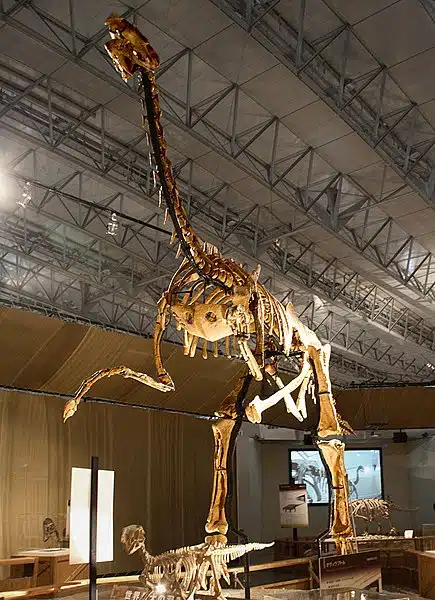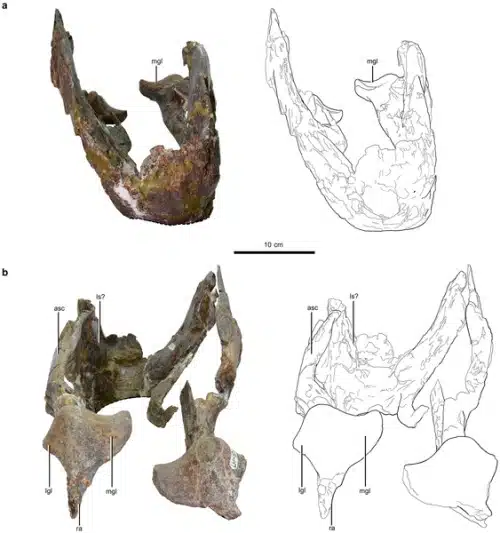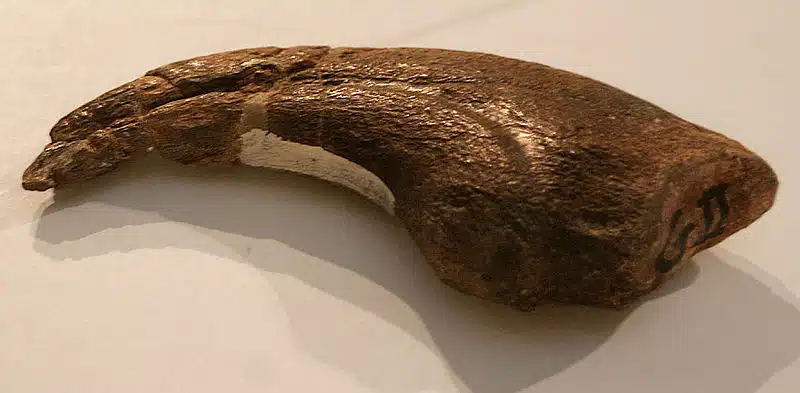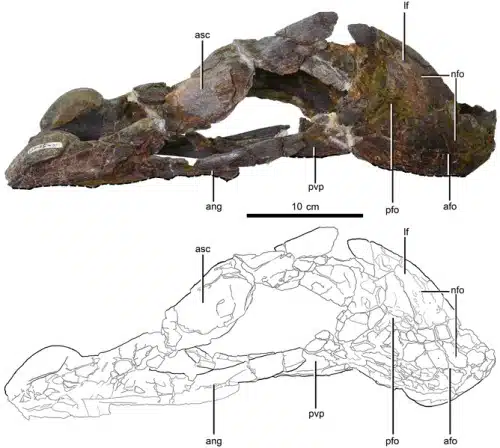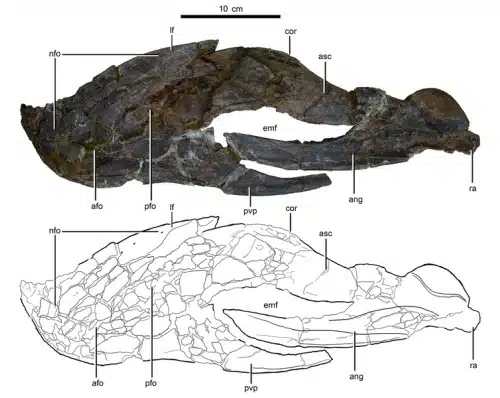Let’s embark on a prehistoric journey that takes us back millions of years to a world vastly different from our own. In this realm of ancient giants and long-lost landscapes, we encounter a creature that stands out even among dinosaurs: the Gigantoraptor. This enigmatic dinosaur, whose very name conjures images of size and mystery, has intrigued paleontologists and enthusiasts alike since its discovery.
Gigantoraptor Key Facts
| Keyword | Fact |
|---|---|
| Pronunciation | Gigan-Toe-Rap-Tore |
| Meaning of name | Giant Thief |
| Group | Sauropod |
| Type Species | Gigantoraptor erlianensis |
| Diet | Omnivore |
| When it Lived | 83.5 to 70.6 MYA |
| Period | Late Cretaceous |
| Epoch | Middle Campanian to the top of the Late/Upper Campanian |
| Length | 26.0 feet |
| Height | 11.0 feet at hips |
| Weight | 1.5 to 2.2 tons |
| Mobility | Moved on two legs |
| First Discovery | 2001 by Xu Xing |
| Described by | 2007 by Xu Xing |
| Holotype | LH V0011 |
| Location of first find | Saihangaobi, Iren Dabasu Formation, Mongolia |
Gigantoraptor Origins, Taxonomy and Timeline
The Gigantoraptor has a name that translates to “Giant Thief”. Its etymology, rooted in Latin, combines ‘gigas/gigantis’ meaning giant, and ‘raptor’ meaning thief. This name is not just a label; it is a window into the creature’s perceived nature and stature.
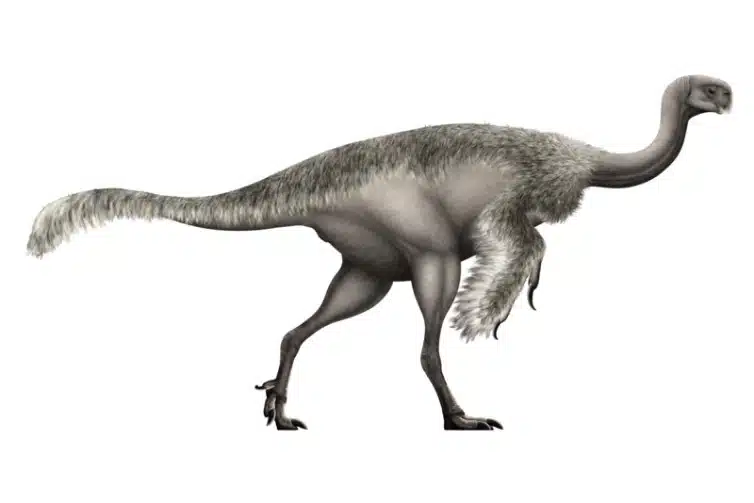
Delving into its taxonomic classification, Gigantoraptor finds its place as a Theropod, nestled within the Caenagnathid family. Gigantoraptor erlianensis is both the type species and only species of this genus.
The timeline of this colossal creature is set in the Late Cretaceous Period, specifically from the Middle to Late Campanian Epoch. This era, spanning 83.5 to 70.6 million years ago, was a time of profound changes and diversification in the dinosaur world.
Listen to Pronunciation
For those curious about the correct pronunciation of this magnificent dinosaur’s name.
Discovery & Fossil Evidence
This tale of discovery reads almost like a script from a paleontological thriller. In April 2005, Chinese paleontologist Xu Xing was participating in a reenactment of the discovery of Sonidosaurus for a Japanese documentary. During the filming, Xu was asked to unearth a thighbone. As he carefully cleaned the bone, a moment of realization struck him. This wasn’t a bone from a Sauropod as initially thought, but rather from a Theropod, comparable in size to an Albertosaurus. Recognizing the significance of this serendipitous find, Xu promptly halted the filming to secure the unexpected treasure. In a twist of fate, the discovery of the Gigantoraptor holotype fossil was captured on film, documenting a pivotal moment in paleontological history.
In 2007, the type species Gigantoraptor erlianensis was formally named and described by Xu, along with colleagues Tan Qingwei, Wang Jianmin, Zhao Xijin, and Tan Lin. The genus name Gigantoraptor aptly combines the Latin words for “giant” and “seizer,” while the specific name, erlianensis, pays homage to the Erlian Basin. The holotype, LH V0011, comprises the incomplete and disassociated remains of a single adult individual, offering a tantalizing glimpse into this colossal creature’s life. It is currently found at the Long Hao Institute of Geology and Paleontology in China.
- Mounted reconstructed skeleton of Gigantoraptor in Japan
- Holotype mandible in lateral, dorsal, anterior and posterior views
- A manual ungual of the holotype
- Holotype mandible in right lateral view
- Lower jaw of the holotype
In a development that adds another layer to the Gigantoraptor’s story, a potential second specimen entered the scene. In 2015, Takanobu Tsuihiji and his team reported the discovery of a large Caenagnathid dentary from the Bayan Shireh Formation. This fragment had been unearthed in 2008 by a joint expedition. It bore striking similarities to Gigantoraptor in both morphology and size. Despite these shared traits, the fragment’s incomplete nature led Tsuihiji’s team to cautiously label it as Caenagnathidae indet. However, authors Rubén Molina-Pérez and Asier Larramendi in 2019 suggested that this partial dentary could be assigned as cf. Gigantoraptor erlianensis, hinting at the possibility of it representing an additional specimen of this enigmatic dinosaur.
Gigantoraptor Size and Description
Imagine a creature that resembles a giant turkey, but with dimensions that defy all expectations. Gigantoraptor, the largest known oviraptorosaur with available skeletal material, presents an awe-inspiring picture. This dinosaur was approximately three times as long and a staggering 35 times heavier than Citipati, the largest previously known oviraptorosaur.
Size and Weight of Type Species
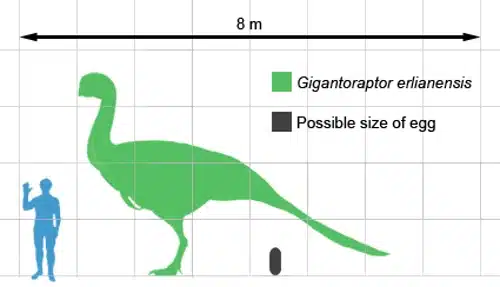
The sheer size of Gigantoraptor sets it apart in the dinosaur world. With an estimated length of 26.0 feet and standing 11.0 feet tall at the hips, it was a veritable giant among its contemporaries. Weighing in at around 1.5 tons, and with some estimates even reaching 2.2 tons, it was not just tall but also robust. These dimensions paint a picture of a dinosaur that was not only large but also likely powerful, dominating its environment with its size and presence. The combination of its size, weight, and potential feathering makes Gigantoraptor a fascinating subject in the study of dinosaur biology and evolution.
The Dinosaur in Detail
Oviraptorosaurs are generally known to have developed feathers, as evidenced by feathered specimens like Caudipteryx and the pygostyle of several Oviraptorids. Given its classification as an Oviraptorosaur, it’s likely that Gigantoraptor also sported feathers. However, considering its massive size, it’s plausible that it may have been partially naked. The lower jaws of Gigantoraptor, preserved at a length of 18.0 inches, were toothless and fused into a broad, shovel-like shape. This suggests that the unknown skull was over half a meter long, also toothless, and likely equipped with a rhamphotheca–or horny beak–adding to its unique and somewhat bird-like appearance.
Unlike other large Theropods, the legs of this dinosaur were not short and stocky to support its massive weight. Instead, both its tibia and femur are over a meter long. This suggests a creature well adapted to running.Its vertebral column had air cavities built in, which would have helped reduce weight.
Interesting Points about Gigantoraptor
- Gigantoraptor’s discovery challenged previous notions about the size range of Oviraptorosaurs.
- Despite its massive size, it’s possible that it was feathered, a trait unusual for dinosaurs of its stature.
- Its beak-like mouth and evidence of omnivorous diet make it a unique case among large dinosaurs.
- The limited fossil evidence makes Gigantoraptor a subject of much speculation and ongoing research.
- Its discovery in Mongolia adds to the rich paleontological significance of the region.
The Gigantoraptor in its Natural Habitat
This omnivorous dinosaur thrived in an environment that was as dynamic as it was challenging. The Late Cretaceous Period offered a landscape marked by diverse vegetation and shifting climates. As an omnivore, it navigated a diet that included both plants and smaller animals, showcasing its adaptability. Its bipedal locomotion suggests a level of agility, perhaps useful in both hunting and foraging. While details about its social behavior remain speculative, its size and diet offer clues about its role in the ecosystem. The Gigantoraptor, in many ways, was a shaper of its environment, influencing both the landscape and the lives of contemporary species.
Contemporary Dinosaurs
In the ancient, sun-drenched lands of what we now call Asia, the Gigantoraptor roamed with a commanding presence. This colossal creature, larger than many of its contemporary Asian dinosaurs, towered over the landscape like a prehistoric titan. Its life was a complex tapestry woven with interactions among the diverse cast of dinosaurs that shared its world.
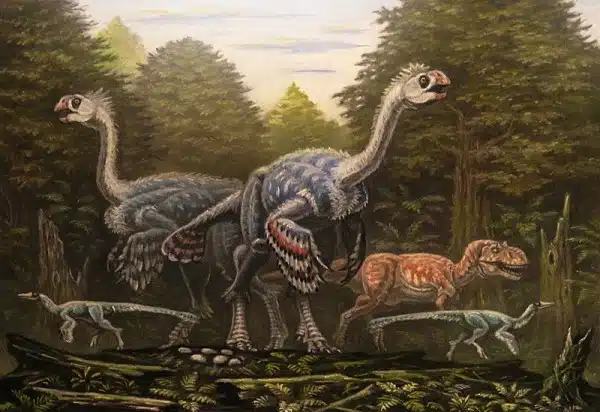
Imagine the Gigantoraptor, a behemoth, striding through the territory where the much smaller Protoceratops grazed. These smaller dinosaurs were roughly the size of a sheep and might have watched warily as the Gigantoraptor passed by. While not direct competitors due to their size difference, there was an unspoken understanding in their coexistence. The Gigantoraptor, primarily an omnivore, might not have actively hunted Protoceratops but its sheer size and potential for opportunistic feeding kept the smaller dinosaur on alert.
In this prehistoric drama, the Pinacosaurus played a unique role. These armored dinosaurs were not to be underestimated though they were smaller than the Gigantoraptor. Their bony armor provided a formidable defense. It’s tantalizing to imagine a scenario where a young, inexperienced Gigantoraptor might have curiously approached a Pinacosaurus, only to be met with a display of defensive prowess that taught the giant a lesson in respecting boundaries.
Then there was the Saurornithoides, a nimble, bird-like dinosaur that was roughly the same size as the Protoceratops. These swift creatures likely darted in and out of the Gigantoraptor’s path, perhaps scavenging leftovers from the giant’s meals or competing for smaller prey. Their interactions were likely a dance of agility versus strength, a testament to the diverse strategies life had evolved to survive.
In this ancient world, the Gigantoraptor was a central figure as a giant among dinosaurs. Its interactions with the likes of Protoceratops, Pinacosaurus, and Saurornithoides painted a vivid picture of life in a time long gone, highlighting the intricate web of relationships that defined their shared ecosystem.
Frequently Asked Questions
It was discovered in 2001 by Xu Xing.
Its name comes from Latin roots and means “Giant Thief.”
It was an omnivore, feeding on both plants and animals.
It was first found in Mongolia, specifically in the Iren Dabasu Formation.
It lived during the Late Cretaceous Period around 83.5 to 70.6 million years ago.
Its massive size combined with evidence of feathers makes it a unique and intriguing dinosaur.
Sources
The information in this article is based on various sources, drawing on scientific research, fossil evidence, and expert analysis. The aim is to provide a comprehensive and accurate overview of the Gigantoraptor. However, please be aware that our understanding of dinosaurs and their world is constantly evolving as new discoveries are made.
This article was last fact-checked: Joey Arboleda, 11-04-2023
Featured Image Credit: PaleoNeolitic, CC BY-SA 4.0, via Wikimedia Commons

